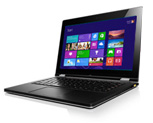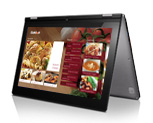Lenovo IdeaPad Yoga 13 Review: One Flexible Ultrabook
Whether in notebook, stand, tent, or tablet mode, the Lenovo IdeaPad Yoga 13 is definitely a head-turner. But does this Ultrabook's innovative multi-mode design effectively juggle its multiple personalities in an equally-harmonious, Zen-like manner?
The World's First Multi-Mode Ultrabook
With Windows 8 slowly picking up momentum, the constantly-evolving touchscreen-enabled hybrid Ultrabook/tablet is also becoming more commonplace. In the race to discover the perfect form factor, PC manufacturers need to think more aggressively outside the proverbial box to earn your business. The IdeaPad Yoga 13 is a prime example of Lenovo’s approach to this unique market.
Labeled as the world’s first multi-mode Ultrabook, the IdeaPad Yoga 13 appears to be ready for virtually any Windows 8 mobility scenario the casual user, student, or professional can throw at it.
The Yoga 13 is capable of assuming any of four different orientations, or "operational modes": Laptop, Stand, Tent, and Tablet.
Laptop Mode
This traditional mode resembles any other clamshell-style Ultrabook or laptop PC. As with all typical laptops, the keyboard and touchpad serve as the primary input in this configuration. However, having the added benefit of a touchscreen provides the Yoga 13 with a welcomed third input option. Obviously, Laptop Mode is useful for basically any task that you would use a notebook for, such as office productivity, photo editing, light gaming, email, and Web browsing, just to name a few.
Stand Mode
In Stand Mode, the screen is capable of being rotated well past 180 degrees. The exposed keyboard and touchpad faces the same surface that the system rests on, so the touchscreen becomes your only input. This mode is particularly suited for viewing video content because, unlike the Yoga 13's next mode, Stand Mode allows you to adjust the tilt of the screen to find that perfect viewing angle. Likewise, this orientation is also great for teleconferencing, since tilting the screen also adjusts what's captured by the embedded HD webcam.
Get Tom's Hardware's best news and in-depth reviews, straight to your inbox.
Tent Mode
Tent Mode is very similar to Stand Mode, though the Yoga 13's screen opens beyond 270 degrees to create a tent shape in this mode. Here, the Yoga 13 stands on its outer display and base edges, with the hinged section facing up, allowing the touchscreen to be aimed towards the user or viewing audience. Tent Mode is handy for viewing recipes in the kitchen, following laptop service manuals in the tech shop, or simply serving as a digital picture frame placed tastefully on a shelf or desk.
Tablet Mode
By rotating the Yoga 13's screen all the way back 360 degrees, we enter its Tablet Mode. In this mode, the back of the screen housing rests on the outer base portion of the system itself, giving the user a solid-feeling touchscreen-only handheld device.
However, in Tablet Mode, the keyboard and touchpad are still exposed to the elements on the rear side of the unit, which is what we like least about this orientation. At least the keyboard and touchpad are automatically deactivated after the screen is rotated beyond 180 degrees (basically anything past Laptop Mode). As expected, Tablet Mode is very capable of performing tablet-oriented tasks such as email, reading, casual gaming, and Web browsing with native support for Adobe Flash and HTML5.
Physical flexibility is not the Yoga 13's only standout feature. This is also one seriously thin convertible Ultrabook.
How Thick Is Thin?
The Yoga 13 is clearly thinner than many of the other Ultrabook solutions out there, including the smaller, swivel-display Dell XPS 12. In fact, at just 0.67" tall, the Yoga 13 even narrowly slides under the MacBook Air's already-impressive 0.68" Z-height.
While retailers are offering some pretty hefty "Ultrabooks", complete with hard disks and even optical drives, the Yoga 13 is a legitimate and true ultra-slim notebook that simply doesn't have enough "Z" to accommodate such old school components.
Starting at $999, the Yoga 13 is available directly from Lenovo USA in numerous customizable configurations. Choice of colors include the default Silver Gray and the flashier Clementine Orange. We opted to keep the color stock, and instead invested in some of the mid- to high-end hardware options offered. The table below lists the system specs of our Yoga 13 evaluation unit:
| Lenovo IdeaPad Yoga 13 System Specs | |
|---|---|
| Processor | Intel Core i7-3517U (Ivy Bridge), 2C/4T, 1.9 GHz Base Clock Rate, 3 GHz Max. Turbo Boost, 17 W |
| Platform | Intel QS77 Express Chipset |
| Memory | 8 GB (1 x 8 GB) PC3-12800 DDR3 @ 1600 MT/s |
| Graphics | Intel HD Graphics 4000 (integrated) |
| Storage | 128 GB Lenovo/Samsung PM830 SSD (SATA 6Gb/s, mSATA Form Factor) |
| Card Reader | SDHC UHS-1-Compatible Multi-Card Reader, |
| Display | 13.3" 10-Point Multi-Touch HD+ IPS @ 1600x900 |
| Wi-Fi | Lenovo Wi-Fi 802.11b/g/n + Bluetooth v4.0 |
| Audio | Intel HD Audio (integrated) |
| Operating System | Microsoft Windows 8 Pro (64-bit) |
| Webcam | 1.0 MP 720p HD (integrated) |
| Ports | USB 3.0, USB 2.0, Headphone/Mic Combo Jack, HDMI v1.4a |
| Battery | 4-Cell Li-ion (14.8 VDC - 3.7 Ah/54 Wh) |
| AC Adapter | 65 W |
| Weight | 3.3 lbs |
| Dimensions | 13.1" (Width) x 8.9" (Depth) x 0.67" (Height) |
| Warranty (USA) | 1 Year with Extension Options (up to 3 Years) |
| Price | $1,330 As Evaluated |
Bundled Software
Overall, Lenovo keeps the third-party bloatware to a minimum on the Yoga 13. Unfortunately, the installation is not entirely pristine. Some of the usual suspects are pre-installed at the factory, and include McAfee’s Security Advisor, eBay, and Skype. Other applications automatically bundled with the system include Evernote, Rara.com music streaming, and Intel’s AppUp gateway. Lenovo also tosses in its own Cloud Storage solution (powered by SugarSync) and its well-balanced Lenovo Support utility. Although an option when ordering our Yoga 13, we opted to proceed without Microsoft Office 2010 being factory-installed.
Current page: The World's First Multi-Mode Ultrabook
Next Page Exterior: First Impressions Are Important-
danaistina I bought a yoga 13 a few months ago. Author of the article obviously has some special version of this ultrabook, which no one else, including me and the people of the Lenovo forums has heard that there is no following problems: touchpad does not support all Windovs 8 gestures, wirerless card has very weak signal, runs very hot and noise from the vents is loud. And finally: windows 8 has not yet up to use touch screen like a android or ios devices.Reply -
danaistina I bought a yoga 13 a few months ago. Author of the article obviously has some special version of this ultrabook, which no one else, including me and the people of the Lenovo forums has heard that there is no following problems: touchpad does not support all Windovs 8 gestures, wirerless card has very weak signal, runs very hot and noise from the vents is loud. And finally: windows 8 has not yet up to use touch screen like a android or ios devices.Reply -
sgadadish Tent (Joke) Mode : simply serving as a digital picture frame placed tastefully on a shelf or desk . , Sure...Reply -
hothfox I contemplated this and the Thinkpad Twist, and wound up getting the Twist, largely because when you flip it around to it's tablet mode, the keyboard and touchpad are covered by the screen, instead of exposed.Reply -
Amdlova 9hr battery... idle and screen of... 5 hr real condition... when we get something can do 12 hrs.Reply -
whyso How is the yoga gettng better bandwidth numbers that it is in theory capable of? 21GB/sec for cached read when theoretically it maxes out at 12.8 GB/secReply -
Kattie Anderson Get a premium support for yoga at http://ytechsupport.com/lenovo-laptop-support-.htmlReply






